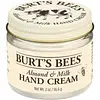What's inside
What's inside
 Key Ingredients
Key Ingredients

 Benefits
Benefits

 Concerns
Concerns

 Ingredients Side-by-side
Ingredients Side-by-side

Prunus Amygdalus Dulcis Oil
Skin ConditioningWater
Skin ConditioningBeeswax
Emulsion StabilisingPolyglyceryl-3 Oleate
EmulsifyingAloe Barbadensis Leaf Juice
Skin ConditioningKaolin
AbrasiveNonfat Dry Milk
Skin ConditioningTocopherol
AntioxidantLonicera Japonica Flower Extract
Skin ConditioningLonicera Caprifolium Flower Extract
PerfumingGlycine Soja Oil
EmollientLecithin
EmollientCitric Acid
BufferingCarrageenan
Sucrose
HumectantAlcohol
AntimicrobialStearic Acid
CleansingAscorbyl Palmitate
AntioxidantGlyceryl Oleate
EmollientGlyceryl Stearate
EmollientPotassium Sorbate
PreservativeSodium Benzoate
MaskingSodium Phytate
Parfum
MaskingPhenoxyethanol
PreservativeBenzyl Salicylate
PerfumingEugenol
PerfumingLinalool
PerfumingPrunus Amygdalus Dulcis Oil, Water, Beeswax, Polyglyceryl-3 Oleate, Aloe Barbadensis Leaf Juice, Kaolin, Nonfat Dry Milk, Tocopherol, Lonicera Japonica Flower Extract, Lonicera Caprifolium Flower Extract, Glycine Soja Oil, Lecithin, Citric Acid, Carrageenan, Sucrose, Alcohol, Stearic Acid, Ascorbyl Palmitate, Glyceryl Oleate, Glyceryl Stearate, Potassium Sorbate, Sodium Benzoate, Sodium Phytate, Parfum, Phenoxyethanol, Benzyl Salicylate, Eugenol, Linalool
Water
Skin ConditioningDicaprylyl Carbonate
EmollientBetaine
HumectantGlycerin
HumectantCetearyl Alcohol
EmollientPrunus Amygdalus Dulcis Oil
Skin ConditioningCetyl Alcohol
EmollientCetearyl Olivate
Isopropyl Myristate
EmollientIsoamyl Laurate
EmollientSorbitan Olivate
EmulsifyingGlyceryl Caprylate
EmollientButyrospermum Parkii Butter
Skin ConditioningTriethanolamine
BufferingArgania Spinosa Kernel Oil
EmollientSclerocarya Birrea Seed Oil
HumectantCarbomer
Emulsion StabilisingHoney
HumectantParfum
MaskingCaprylhydroxamic Acid
Tocopheryl Acetate
AntioxidantSodium Citrate
BufferingRosa Canina Seed Oil
EmollientHydrolyzed Collagen
EmollientSqualane
EmollientCassia Angustifolia Seed Polysaccharide
Skin ConditioningHydrolyzed Hibiscus Esculentus Extract
Skin ConditioningDextrin
AbsorbentUbiquinone
AntioxidantWater, Dicaprylyl Carbonate, Betaine, Glycerin, Cetearyl Alcohol, Prunus Amygdalus Dulcis Oil, Cetyl Alcohol, Cetearyl Olivate, Isopropyl Myristate, Isoamyl Laurate, Sorbitan Olivate, Glyceryl Caprylate, Butyrospermum Parkii Butter, Triethanolamine, Argania Spinosa Kernel Oil, Sclerocarya Birrea Seed Oil, Carbomer, Honey, Parfum, Caprylhydroxamic Acid, Tocopheryl Acetate, Sodium Citrate, Rosa Canina Seed Oil, Hydrolyzed Collagen, Squalane, Cassia Angustifolia Seed Polysaccharide, Hydrolyzed Hibiscus Esculentus Extract, Dextrin, Ubiquinone
 Reviews
Reviews

Ingredients Explained
These ingredients are found in both products.
Ingredients higher up in an ingredient list are typically present in a larger amount.
Parfum is a catch-all term for an ingredient or more that is used to give a scent to products.
Also called "fragrance", this ingredient can be a blend of hundreds of chemicals or plant oils. This means every product with "fragrance" or "parfum" in the ingredients list is a different mixture.
For instance, Habanolide is a proprietary trade name for a specific aroma chemical. When used as a fragrance ingredient in cosmetics, most aroma chemicals fall under the broad labeling category of “FRAGRANCE” or “PARFUM” according to EU and US regulations.
The term 'parfum' or 'fragrance' is not regulated in many countries. In many cases, it is up to the brand to define this term.
For instance, many brands choose to label themselves as "fragrance-free" because they are not using synthetic fragrances. However, their products may still contain ingredients such as essential oils that are considered a fragrance by INCI standards.
One example is Calendula flower extract. Calendula is an essential oil that still imparts a scent or 'fragrance'.
Depending on the blend, the ingredients in the mixture can cause allergies and sensitivities on the skin. Some ingredients that are known EU allergens include linalool and citronellol.
Parfum can also be used to mask or cover an unpleasant scent.
The bottom line is: not all fragrances/parfum/ingredients are created equally. If you are worried about fragrances, we recommend taking a closer look at an ingredient. And of course, we always recommend speaking with a professional.
Learn more about ParfumPrunus Amygdalus Dulcis Oil comes from the sweet almond, a tree native to Iran. This oil has no fragrance and is non-volatile.
Almonds contain healthy fats, vitamins, and minerals. It is a rich source of Vitamin E, a great antioxidant and skin conditioning ingredient. Sweet almond oil contains fatty acids such as linolenic acid and triglycerides.
The content of sweet almond oil makes it a great emollient; it can help soften and hydrate your skin. Emollients create a barrier over your skin to trap moisture in. Sweet almond oil has antioxidant properties.
Those with an almond allergy should be careful of this ingredient and speak with a professional about using it in your skincare.
This ingredient may not be fungal-acne safe.
Learn more about Prunus Amygdalus Dulcis OilWater. It's the most common cosmetic ingredient of all. You'll usually see it at the top of ingredient lists, meaning that it makes up the largest part of the product.
So why is it so popular? Water most often acts as a solvent - this means that it helps dissolve other ingredients into the formulation.
You'll also recognize water as that liquid we all need to stay alive. If you see this, drink a glass of water. Stay hydrated!
Learn more about Water